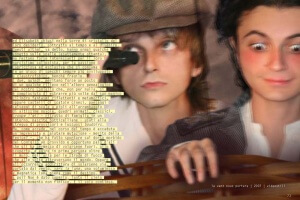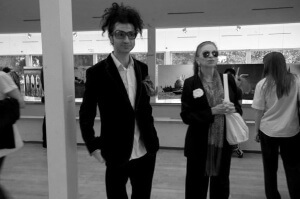Tommaso Labranca – ConiglioViola Valentino
In the oeuvre of ConiglioViola, Viola Valentino is not merely the object of a tribute, or an unbearably snobbish mockery of popular culture to earn the favour of a faux sophisticated audience. Viola Valentino and Berté, Marcella, Alice and Milva are in fact very similar to the trains in the background of de Chirico’s works or the clowns in those of Picasso.
Pop divas are real elements of daily life that the artist fantasizes about, and then bodily incorporates into works of art. Because each of them represents and narrates their surroundings, and as we all know, when writers from Bagnacavallo tire of writing about their home town and imagine they are in Zurich, they get it badly wrong, because they have never been to Zurich, and they describe it as Bowie described the chill of Warsaw from a cosy recording studio in a lavish French castle, with a few notions floating down an affected version of the Vistola river.
But critics like these messy historic/geographical lucubrations that ennoble the daily life they have come to hate. And they like it even more when they can season the lot with the sauce of psychoanalysis. Perhaps with the help of a bored philosophy teacher, who saw himself writing important treatises but is actually teaching at the Bartoletti School to earn a living. One day this jobsworth teacher mentioned Freud’s Psychopathology of Everyday Life. The critic was in the front row listening to him, while the rest of the class was playing fantasy football. Perhaps in that moment of daily life, made of boredom and football, the thing took a negative turn, and the critic became a psychopath. Then the bad teacher spent another morning illustrating the painting of Leonardo’s in which the outline of a bird is visible. After that the critic started to look at every work of art as a puzzle to solve, like: fill in the dotted spaces and an image will appear. It all got worse when many young artists noticed this tendency and realised that the best way to win the admiration of the Psychopathological Critic was to become psychopaths themselves. So it was that they all started including hidden birds in their pictures. And everyone was happy. The critics were happy every time they solved a riddle, the artists were happy because they had been elevated to the rank of neurotics, and the gallerists were happy because thanks to these pathologies they were making more money than Lacanian psychoanalysts.
Viola Valentino, as she appears in the works of ConiglioViola, on the other hand, has no hidden psychoanalytical references. Viola is like Gertrude Stein’s Rose: Viola is Viola is Viola. Who would have thought it? The very Stein who told the story of going to see the Medrano circus in Paris one night with Picasso and a few other scroungers from Rue de Fleurus. They liked it so much that Picasso even started painting clowns again, as he had in Spain, drawing on an enthusiasm born out of everyday life and not the meanders of psychoanalysis. In the same way, ConiglioViola draws on the everyday life of twenty years ago: the musical tastes of older sisters who followed the unattainable divas of the day on the Festivalbar programme. Divas who are probably now in the contacts of the mobile phones of Mr. Brice Coniglio. But their vicinity does not diminish their historic importance, because they have always been that way: distant but nonetheless “familiar in his mouth as household words”, as Shakespeare says in Henry V.
ConiglioViola’s pop divas are indeed household names, the stuff of conversations around the dinner table with the older sisters, their great fans. Just like de Chirico’s trains were talked about over dinner with his father, a railway engineer.
Trains, clowns and singers are not the fruit of Seelenkrankheiten, but visions of daily life. Yet there is a further level that makes these everyday elements magical, and that makes them into art, not just because they are on show in a museum. It is the transfigurative capacity of the artist, who identifies aspects of the most banal things that non-artists simply do not see.
ConiglioViola’s pop divas reach their full power when they are crystallized in the perfection of their utmost splendour, enveloped in the amber of memory where they will never age. The imperfections of the clothes; the odd missed note during their live performances; the tangle of cables on the stage; the sweat: all these things disappear. ConiglioViola’s taxidermic operation removes all unwanted details from the animal being video-preserved. Everything is magical, glossy, perfect. It is not a difficult task, because the original material was already laden with allure. The pop divas of the early
80s were masks that underwent a new transformation every season. “Who knows what Berté’s new look will be this summer?”, we wondered anxiously before going to sleep. And then we would be captivated at the sight of Loredana dressed as a pirate or a nun, in Warhol’s Factory or under a waterfall, or Rettore, who morphed year by year from extraterrestrial to kamikaze to country singer. Decades later we laugh to see Madonna doing the same things as the diva from Castelfranco Veneto. But she has more money to plough into it, and therefore manages to conquer Indonesia, while for Rettore even Canton Ticino was a result. Italy, unfortunately, lost its global artistic supremacy in the seventeenth century.
Unlike normal works of taxidermy, however, those of ConiglioViola are not mournful things. A stuffed fox, with its paw raised in a pathetic gesture of vitality, and glass eyes that betray neither fear nor cunning, is a dismal sight. The digital embalming of the 1982 version of Milva, on the other hand, magnifies the singer’s original splendour. Also because in these works you do not actually see Milva or Berté or Alice. What you see is ConiglioViola reclaiming 80s pop divas and transforming their music and ideas. ConiglioViola also invites us to do the same: “Recuperate le vostre radici quadrate” (reclaim your square roots). Perhaps the term roots was chosen by a paralinguistic process: as in Jewish or Arabic words that contain age-old three-letter roots that give terms their meaning, in ConiglioViola’s videos we perceive ancient (in pop terms) diva-related roots that give meaning to the art of the Coniglio. Those roots are square because the splendour of those pop divas is still vastly superior to what came after them. While the divas of the 80s were whimsical, astounding, ever-changing pop-singers, those of the following decade took on the saccharine, temperamental and arrogant form of the top models in George Michael’s videos, grouped together as if in a school photo. And ten years later the divas that delight the chat room onanists in are the vacuous soubrettes on television, the bubbly showgirls, the presenters in their miniskirts and stilettos, the paid habituées of the Costa Smeralda in Sardinia, all so very feckless and interchangeable. And who knows what will happen in the next decade, when the magnificent pop divas of the 80s come up against their descendants, who will quite likely be sportswomen, especially swimmers?
In the end it is neither here nor there. For some of us the figure of the diva will continue to be what we saw on the stage at the Sanremo music festival or in the first sparkling variety shows on the Mediaset channels between 1978 and 1985. We can live embalmed too, fixing these equally embalmed pop divas into a loop of .avi files, while outside the world goes on without us.
Tommaso Labranca

 Previous Post
Previous Post Next Post
Next Post


